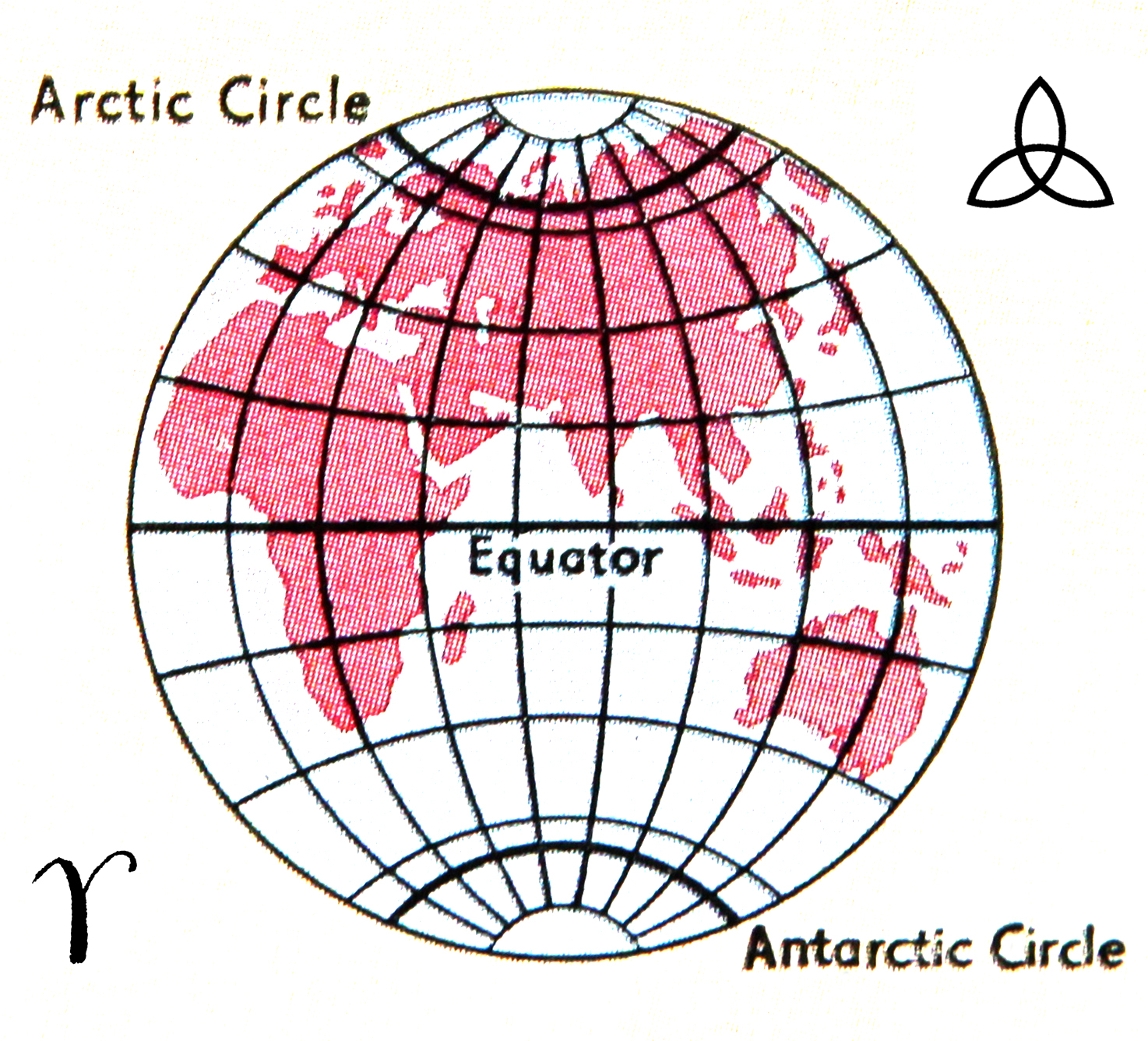Julie & Veronica
Once, to wander the streets of Venice in the dead of night was to be truly alone. Now, with osterias staying open late for more and more tourists, you may have to be patient, perhaps go to the back of San Pietro di Castello to find all shuttered and no sound at all, except your own muted footsteps or the movement of water against ancient stones. For the Italian Pavilion of the 2017 Venice Art Biennale, an artist born in the city, Giorgio Andreotta Calò, installed a dark flooded platform. ‘Untitled (The end of the world)’ reflects and inverts the vaulted ceiling of an old shipbuilding warehouse. This city is a place he loves and detests: ‘You can live in Venice, but not as a Venetian. Venetians don’t exist anymore.’ For him, it is only at night, until dawn that the city is ‘calm, emptied, silent, you can still see it...’
Iosif Aleksandrovich Brodsky favoured Venice in the ‘dead season’; despite having been sent to work for 18 months on a farm in the Arctic for his 'social parasitism’ - his penalty commuted from 5 years, his poetry considered pornographic and anti-Soviet - yet still he preferred the melancholy air of a damp winter evening, the smell of freezing seaweed reminding him of the Baltic. He liked to walk until dawn, along ‘these long, coiling lanes and passageways that beguile you to see them through, to follow them to their elusive end.’ On one such stroll, he shared his thoughts with the Hungarian writer Charles Fenyvesi. Water, he said, stores our reflections for when we are long gone; he thought it the only force capable of erasing time and he marvelled at how the founders of Venice here – those ‘magicians’ - had worked out how to subdue the sea in order to subdue time. Brodsky is buried here in San Michele cemetery, where you will also find the graves of Igor Stravinsky and Sergei Diaghilev, from an earlier generation of émigrés.
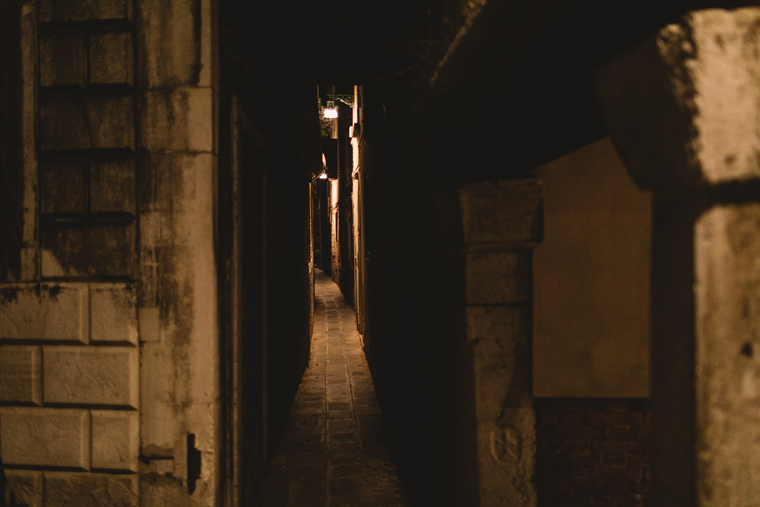
Venice was made by refugees, whose old world had died, who escaped to these muddy islands in the lagoon. Legend has it that this city of waters was founded on 25th March 421, at midday exactly. Here is a place that is on the edge of the modern world and yet somewhere ‘other’ – no longer the zenith of commerce between East and West, it is a place of reincarnations, suggestions and dissolutions. At this hour, beyond midnight, you are unlikely to meet anyone or hear anything but your own muted footsteps or the movement of water against ancient stones. If there were to be a soundtrack to accompany this night walk it might well be Mahler’s Kindertotenlieder, Songs on the Death of Children, seeping out from unrestored and bricked up facades, an echo that resounds through a constellation of calli, sottocalli, sottoportico, and drifts like a mist underneath the bridges. The bridges. Here, there and everywhere, connecting, guiding, misleading. Are there four hundred and sixty or four hundred and eighty? Who really knows how many?
And such names, which reveal to us there is a power in naming, and behind each name another story to be told. Cross the Bridge of Marvels or the Bridge of Fists, the Bridge of Courtesy, of Tits, of Rooms, of Merciful Hope, of Devils, of Rubbish or of the Dead. Walk on the Bridge of Bare Feet, of Spirits, of the Honest Woman, of Straw, of Humility. These are some I have remembered.
Walk across Campo Santa Margherita, past the little stone building standing on its own (it once housed the Guild of Fur-Makers) and go down past the Carmini Church to the Fondamenta Del Soccorso. Not far along here, on the other side of graffitied canal-side hoardings – which ask ‘VENEZIANI AVIDATÁ O SALVEZZA?’ – you might find, past the Armenian College, the bone-white building which was a home for reformed prostitutes in the 16th century, set up by Veronica Franco, a former courtesan acknowledged for the quality of her poetry and artistic salon.
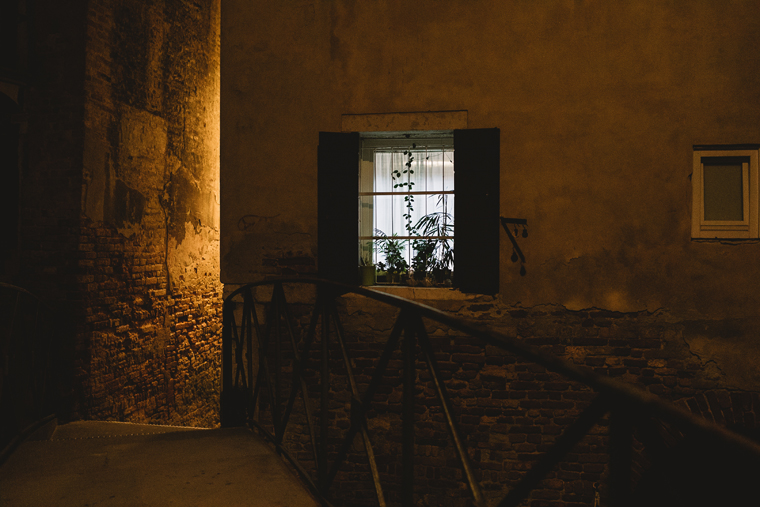
Here are the ghosts of lost activities and forgotten souls, some of which we may recover this night. Go further, through Campo Angelo Raffaele, beyond the unpretentious and boarded up parish restaurant, its sign half missing and rusted over. Here was once a place of sheet metal works, cotton mills, furniture workshops, wax factories and boat builders, a working-class district. Here, on the other side of a police barracks, are remnants of the commercial port facing Guidecca canal, metal buttresses shoring up her banks in an area undergoing reclamation. Long brick warehouses, cleaned up, now house a branch of the Instituto Universitario di Architettura di Venezia. Near here, bound on three sides by canals, is the Church of San Nicolo Dei Mendicoli, as good a destination as any at this empty hour. This church has remained almost unaltered for 800 years, built as it was in this poor area of fishermen, sailors, beggars (the mendicoli) and pizochere, the penitent ex-prostitutes. There were few rich merchants here willing to invest in this particular house of God. Nearby, along the Guidecca canal, the lights of the docked cruise ships send a warm orange glow across the waters.
This church, dark by night and dark by day, with its gilded wood statues and frescoes, sat below the level of the surrounding canals and depreciated and decayed over the centuries. Jan Morris described the interior, with the Virgin in a dark red velvet dress, as ‘weird, shadowy, barbaric, gleaming, candle-lit’. It was one of the first buildings chosen to be restored in the 1970s by the UK Venice In Peril Fund, its reclamation incorporated into the ‘dreamlike textures’ of Don’t Look Now, a film by Nic Roeg. Set in winter, it tells the story of a handsome couple, John and Laura, played by Donald Sutherland and Julie Christie, both haunted by the death by drowning of their young daughter. They meet two elderly sisters, one of whom is a blind medium, who claims to see their lost child. Laura desperately wants to believe but John is derisive – then, after nightfall, he catches glimpses of a little figure dressed in red running alongside the shadowy canals, that red coat she was wearing that fatal day.
‘They say seeing is believing. But only a split second separates the past from the future. The present is crushed between them,’ spoke a voiceover on the movie’s original trailer (available on the DVD but not used here in this trailer). The film was voted Number 8 in the British Film Institute’s 100 Favourite British Films of the 20th Century. At the time of release in 1973, it drew some notoriety from a beautiful and intense depiction of love-making between the leads. When Don’t Look Now was first shown on television in 1979, the BBC entirely cut out the scene, but so many viewers rang in to complain – asking for it to be reinstated – that when it was shown again there were no cuts. In an interview decades later, Sutherland recalled: ‘What made the scene wonderful was the editing. Never staying on us for more than a few seconds and then cutting to the two of us getting dressed, back and forth, the audience never ended up being a voyeur, they watched a cinematic collage and were reminded of themselves. That’s what made it sexy and remembered; it was about them, the viewer, not about us, Julie and me. That’s why it seems so real to everyone. It was real in their imagination. It had happened. To them though, not to us, we were just a catalyst for their imagination.’
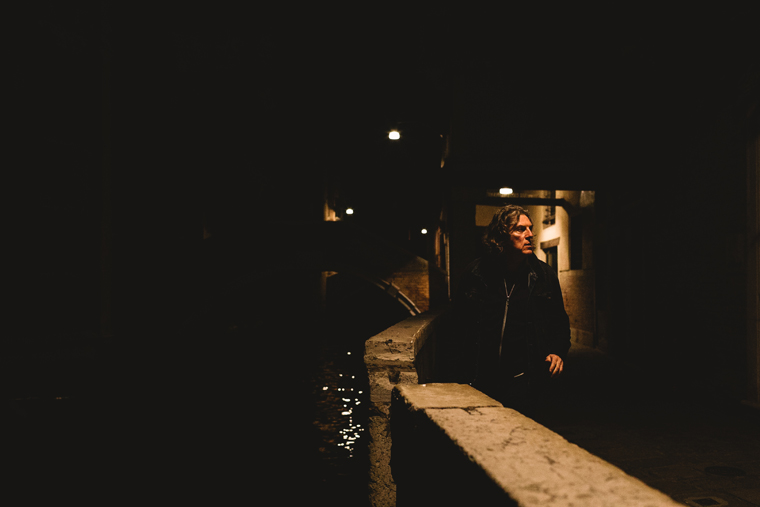
Now, from the driftwood of memory, a distant connection comes to my mind. At a college I attended in the 70s there was a lecturer in lithography whom I mostly saw propping up the local bar, part of a crowd intent on smoking and drinking heavily. Our peers said he had been some kind of hot-shot down in London back in the Sixties, though they never elaborated, and here we were in a provincial backwater. He was affable and charming, patient in explaining techniques, but the smiles seemed to mask an unhappiness. Once, I wandered into the empty print-making department (pub opening hours) and passed behind a blue curtain into his inner sanctum of inks and pastes and cleaning lubricants and the detritus of ages to find his broom cupboard size office. (Hideaway? Den? Depository of ancient wisdoms?) In the clutter of images and postcards, colour charts, stock orders, handwritten notes and invoices stuck to the wall was a yellowing newspaper cutting with an apparition of this man, leaner, so much younger and unlined – but the same haircut – in a dinner suit, arm in arm with an equally youthful and exquisite woman. The caption: ‘Miss Christie arrives at the premiere of…’but this last part is torn away, unknown. There is no background visible, just she and he captured in the glare of the flashbulb and reduced to halftone dots on newsprint.
He first met her at Christmas, 1962, delivering a letter to her door, working as a temporary postman while a Gold Medalist student at the Royal College of Art, she a little-known actress about to play in her first film, Billy Liar. This one cold frosty morning, a chance encounter, a fated moment. They fell in love, as these things go, and moved in together. Less than a year later she will be sharing a cigarette with Tom Courtney at Venice Film Festival, two unknown hopefuls promoting their kitchen sink drama. A revelation on screen, she is destined to win an Oscar in 1965 for her role alongside Dirk Bogarde and Laurence Harvey in John Schlesinger’s Darling, an account of the amoral side of London in the Swinging Sixties. In the summer of 1965, with her star in the ascendant, Christie and her postman-artist lover became engaged in Spain, where she was filming Doctor Zhivago. He returned to London to find himself sacked from his part-time teaching job at St. Martins, allegedly because of the publicity over their affair, such was the double-edged morality of the time. This affair, however, peters out in the face of a new world defined by vanity and celebrity, as other star actors compete for her affections. He moves to the Midlands to another teaching post, to be alone, with a heart I suspect that will never heal. She is independently minded, wilful – capricious even – not one who will give her hand in marriage, for these are revolutionary times when behaviours and codes are questioned, revised and rejected.
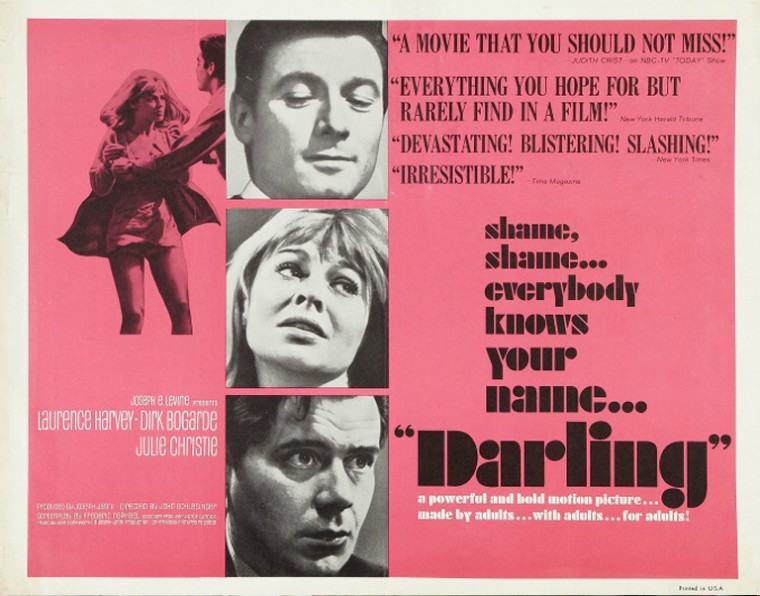
In Darling, Bogarde says to Christie, “Your idea of being fulfilled is having more than one man in bed at the same time.” Life imitates art or does art reflect life? An eternal question. How do you maintain your personal integrity, your sense of your real self in the midst of social change? When, in a time of vacillation, life seems meaningless and each action you make does not seem to change anything? When your own pleasure is of central importance and above all other consideration? (Though the paradox of hedonism is at least as old as the Greeks.) How do we explore our capacity for love in a world that demands relationships are treated like any other consumer goods, when non-conformity is reduced to a brand value?
Let us go back to 1565 when, at 20 years of age and no doubt as incandescent a beauty as Christie, Veronica Franco was listed in Il Catalogo di tutte le principale et piu honorate cortigiane di Venezia, a guidebook which gave the names, addresses, and fees of the most prominent prostitutes in the city. There were 210 listed, out of a total 11,654 at work here. She just made it into the chart at number 204. It also contained the names of their Procuresses, often their own mothers. Prices ranged from 1 scudo to 30 scudi. Veronica at this time cost a mere 2 scudi, but as her reputation grew it was reported that the minimum price for one kiss was 6 scudi and ‘la négotiation entiére’ was worth 50 scudi. The 22-year-old Henri de Valaise, en route to be crowned King of France, chose her and her alone to entertain him. She, in return, would later dedicate two sonnets to him. Venice was at that time, apart from amassing unbelievable fortunes from the confluence of its all-conquering trade, cunning politics and military stratagems, a city of absolute voluptuous delights. Contemporary English plays made light comedy of Venetian vices – speaking of ‘moist-handed Madonnas’ and ‘most rare and divine creatures’.
‘So it pleaseth the destinies that I should thirst to drink out of a most sweet Italian vessel’ speaks one character in a play attributed to Thomas Middleton – though prostitutes were also simply called ‘commodities’ or ‘lac’d mutton’. Sir Stephen Powle wrote in 1587 to a friend that he considered Venice to be ‘the Paradise of all pleasure that may be possibly devised or imagined’. He described how, in his lodgings, he was – quite literally – surrounded by courtesans going about their business: ‘Over my head hath Lodovica Gonzaga the French Kinges mistis hir house; you think it peradventure preposterous in Architecture to have hir lye over me’. He considered himself ‘well hallowed to be amongst so many saints’. These ladies could be seen bleaching their hair in the sun on the high terraces – continually moistening their hair with a small sponge, adding a mixture of vine ash and an infusion of lupins, saltpetre, endives, alum, saffron and madder, even urine, to lighten their hair to a desirable gold blonde.
Veronica had married young, bore a child but then left her husband – it was a loveless union. While it was possible to be granted a divorce, it was almost impossible to claim any material benefits, even the original dowry. To leave a marriage was, for a woman, to do so penniless; and thus she pursued the only option open to her. The Courtesan was the highest calibre of prostitute, one who could engage both physically and intellectually with the client, with songs, poetry, scholarly conversation, as well as enthusiastic and imaginative sexual intercourse. The most successful of these, through achieving platonic male patronage, would become known as an Honest Courtesan.
Veronica also created and published her own poetry and letters, written from an ardent and independent female point of view – a stylistic departure – speaking out in areas where women had traditionally been silent.
I am in bed with one who, as I sense,
loves and enjoys me, I become so delectable and
tender that my pleasure surpasses all other
delights, and what appeared to be the tightest
of love knots becomes yet tighter.
Her main patronage came from Domenico Venier, a powerful Venetian senator and a noble. He helped her furnish her own library – a collection of books that was the envy of European intelligentsia – and they ran an influential artistic and literary salon. She founded a home for unwed mothers and former prostitutes, while also campaigning for the City to enforce laws stopping mothers from the common practice of prostituting their daughters. When the Plague came to the lagoon, she left the city for two years, constantly writing, but returning to find her house ransacked and her reputation under attack. As a sexual and cultural icon once celebrated as the very embodiment of La Serenissima, she was now a target of male jealousy, not least from those in far less successful literary circles. As someone who refused to be entirely defined by the male hierarchy, she was castigated as ‘a witch and a public whore’ and brought before the Inquisition.
Accused of practising magic incantations, she was finally acquitted, but her reputation never quite recovered. Soon after, with the death of her patron Venier, her finances fell into disarray and she died in poverty aged 45.
Her house on Fondamenta Del Soccorso, once a place of hope, not so far from the Church of San Nicolo Dei Mendicoli, is closed up, its interior another Venetian mystery. Place your cheek against the stone here and breathe in the past; but there is little here this night, none the multiplicity of sensual pleasures that the Venetians once revelled in, murmurs or sighs that are not of the ever-present water. Venice, a city of the past, of secrecy, of romance, of mudflats, of desires, farewells and returns, bringing forth these meanderings.
Instead, let us remember that postman turned lithographer in his solitude, suffering from throat cancer, who dies aged 51. Let us dedicate these verses from her Capitolo 13 to him, and to this thought: I was loved and I loved someone.
Come here, and, full of moist wicked desire,
braced stiff for your sinister task,
bring with daring hand a piercing blade.
Whatever weapon you hand over to me,
I will gladly take, especially if it is sharp
and sturdy and also quick to wound.
Let all armour be stripped from your naked breast,
so that, unshielded and exposed to blows,
it may reveal the valour it harbours within.
Let no one else intervene in this match,
let it be limited to the two of us alone,
behind closed doors, with all seconds sent away.
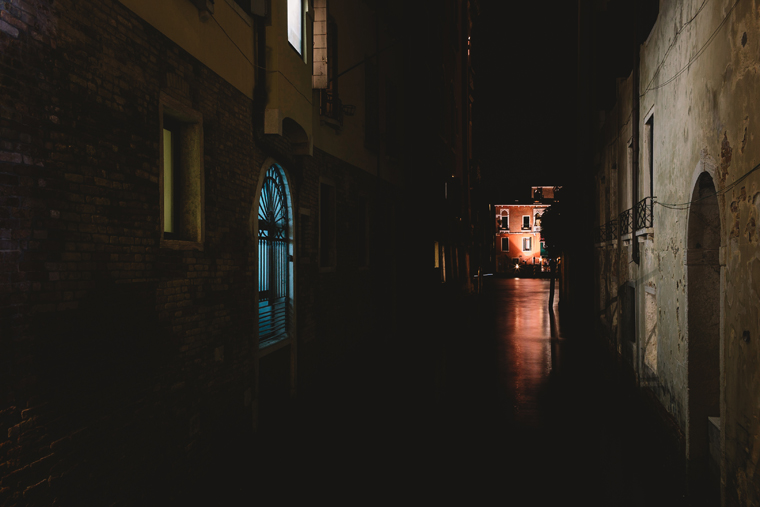
Night photographs by Kate Jackson, 2017
